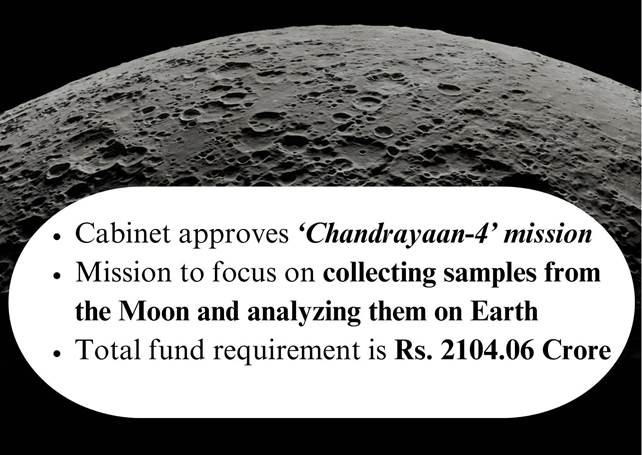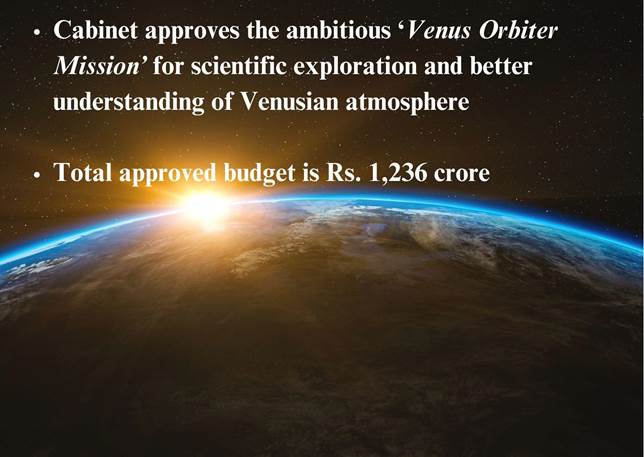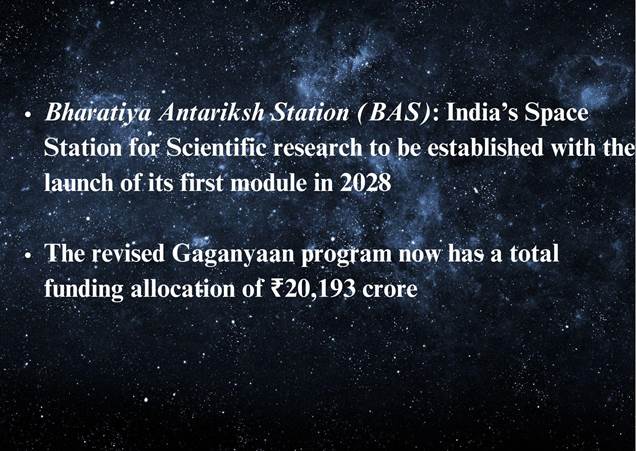Expanding Horizons in Space Sector: From Lunar Exploration to a National Space Station
India is charting a bold course in space exploration, with an array of visionary missions and projects approved by the Union Cabinet. These initiatives, led by the Indian Space Research Organisation (ISRO), signal the nation’s commitment to becoming a leader in space technology and research. From the upcoming Chandrayaan-4 mission and Venus Orbiter Mission to the ambitious Bharatiya Antariksh Station (BAS) project, the Government of India is significantly expanding its space program during the Amrit Kaal. These projects aim to enhance India’s technological capabilities, foster industry collaboration, and strengthen the country’s position in global space exploration.
Chandrayaan-4 Mission
Chandrayaan-4 mission, aims at developing and demonstrating key technologies required for returning to Earth after a successful lunar landing. This mission will also focus on collecting samples from the Moon and analyzing them on Earth. Chandrayaan-4 is a critical step toward establishing India’s capabilities for a human mission to the Moon, planned for 2040. The mission will showcase advanced technologies for docking, undocking, landing, and returning safely to Earth, alongside lunar sample collection and analysis.
The successful soft landing of Chandrayaan-3 demonstrated vital technologies that only a few nations possess. Building on this, Chandrayaan-4 will focus on returning lunar samples safely to Earth, a critical capability in future manned missions. The mission, managed by ISRO and expected to be completed within 36 months of approval, will have strong participation from industry and academia. All critical technologies will be developed indigenously, creating high employment potential and technological spin-offs for other sectors. The total funding requirement is Rs. 2,104.06 crore, covering spacecraft development, two launch vehicle missions of LVM3, external deep space network support, and special tests for design validation.

The mission will empower India to achieve self-reliance in key technologies essential for manned space missions, lunar sample retrieval, and the scientific examination of lunar materials. A significant collaboration with Indian industries is planned, fostering broad engagement in the mission. Additionally, Indian academia will be actively involved through Chandrayaan-4 science meetings and workshops, creating opportunities for knowledge sharing. The mission will also establish specialized facilities for the preservation and analysis of the lunar samples brought back, turning them into valuable national assets for future research and development.
Venus Orbiter Mission
The ambitious Venus Orbiter Mission (VOM) marks a major step forward in India’s planetary exploration efforts beyond the Moon and Mars. Venus, the planet closest to Earth and believed to have formed under conditions similar to our own, presents a unique opportunity to study how planetary environments can evolve in dramatically different ways. This mission aligns with the government’s long-term vision of advancing space exploration capabilities.
The Venus Orbiter Mission, led by the Department of Space, will place a scientific spacecraft in orbit around Venus. The mission aims to improve our understanding of the planet’s surface, subsurface, atmospheric processes, and the Sun’s influence on its atmosphere. Investigating the causes behind Venus’s transformation from a potentially habitable planet to its current state will provide crucial insights into the evolutionary paths of both Venus and Earth. ISRO will oversee the development and launch of the spacecraft, following its well-established project management practices. The data collected from the mission will be shared with the scientific community, fostering further research. The mission is expected for launch in March 2028, offering significant scientific insights and various outcomes, particularly in answering unresolved questions about Venus.

The total approved budget for the Venus Orbiter Mission is Rs. 1,236 crore, with Rs. 824 crore allocated to spacecraft development. The cost includes development and realization of the spacecraft including its specific payloads and technology elements, global ground station support cost for navigation and network as well as the cost of launch vehicle.
The mission is expected to strengthen India’s capabilities for future planetary exploration, with the potential to handle larger payloads and optimize orbital insertion techniques. It also involves extensive collaboration with Indian industry for the spacecraft and launch vehicle, creating significant employment opportunities and technological benefits across sectors. In addition, academic institutions will play a key role in training students in areas such as design, development, testing, and calibration in the pre-launch phase. The mission’s advanced instruments will generate new, valuable data for the Indian scientific community, creating exciting new research opportunities.
Bharatiya Antariksh Station
The construction of the first module of the Bharatiya Antariksh Station (BAS-1) marks a significant expansion of the Gaganyaan program. This decision paves the way for missions aimed at developing and validating the technologies required to build and operate the Indian space station. The revised scope of the Gaganyaan program will now include precursor missions for BAS, additional hardware requirements, and the inclusion of an additional uncrewed mission.
The Gaganyaan program, initially approved in December 2018, was designed to launch human spaceflight missions to Low Earth Orbit (LEO) and lay the groundwork for India’s long-term ambitions in human space exploration. The expanded vision of the Indian space program during Amrit Kaal includes establishing an operational Bharatiya Antariksh Station by 2035 and sending an Indian crewed mission to the Moon by 2040. The program will involve eight missions, to be completed by 2028, including the launch of the first unit of BAS-1.

ISRO will lead the Gaganyaan program, working closely with industry, academia, and other national agencies. Four missions under the current Gaganyaan plan are expected by 2026, followed by four additional missions focused on demonstrating and validating technologies for the space station by December 2028. India will acquire vital capabilities for human space missions to LEO through the establishment of BAS. This national space facility will significantly enhance microgravity-based scientific research and technology development. The resulting technological advancements will likely lead to innovations across multiple sectors. Additionally, the program is expected to spur increased industrial participation and economic activity, generating employment, particularly in high-tech fields related to space and allied industries.
The revised Gaganyaan program now has a total funding allocation of ₹20,193 crore, with an additional ₹11,170 crore in newly approved funding. The program will present an exciting opportunity for India’s youth, inspiring careers in science, technology, and microgravity research, ultimately benefiting society through the resulting technological innovations and advancements.
Union Budget 2024-25
Significant announcements have been made in relation to the infrastructure sector in the Union Budget 2024-25, presented by the Union Minister of Finance and Corporate Affairs Smt. Nirmala Sitharaman. A Rs. 1,000 crore Venture Capital Fund for space startups has been launched to catalyze growth in the burgeoning space sector, positioning India as a key player in the global space economy.
Conclusion
India’s space program is entering an exciting new phase, marked by ambitious missions and unprecedented technological advancements. The approval of Chandrayaan-4, the Venus Orbiter Mission, and the Bharatiya Antariksh Station demonstrates the government’s commitment to advancing the country’s space exploration capabilities. These projects not only elevate India’s standing in the global space arena but also catalyze technological innovation and create significant employment opportunities. As India forges ahead with its space ambitions, these missions will ensure that the country remains at the forefront of scientific discovery and space research for decades to come.
“Keep the Passion Alive Till the 23rd”: CM Hemant Soren
Ranchi: Chief Minister Hemant Soren uplifted the spirits of the candidates and party worke…


















